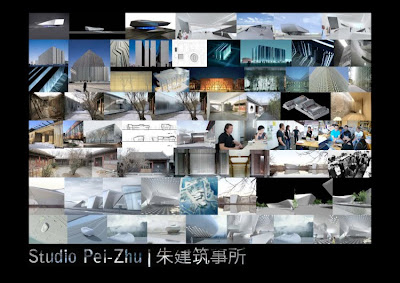Studio Pei Zhu is an avant-garde architectural practice based in Beijing, China. The practice belief in practical solutions in reflecting their strong and innovative conceptual thinking in design. Their design approaches are always critical in resolving problems in modern China’s complex mixture of traditional and contemporary settings.
Design Philosophy
Studio Pei Zhu’s philosophy in responding to the above mentioned complex context are always a reflexive one. The current rapid modernization of urban China is being seen as a mix-marriage between old and new, thus forcing their design thinking and approach to adapt a kind of exploration in reconnecting the modern urban conditions to its roots, which are very rich, culturally and socially.
This philosophy has led the design practice to a unique method of reinterpreting the vernacular in a contemporary context. Most of their projects are being treated as tools in connecting process to products.
Design Objectives and Methods
In connecting design process to its final products, which is the way the practice function, Studio Pei Zhu has establish a strong framework in producing architectural pieces with unique aspiration, which they hope to be responsive and reflexive enough to survive and make a better impact in the rapid phase of modernization that China is experiencing.
The process of exploring various methods in approaching each design problems are always being conducted within a strong hold belief in an abstract insertion of old and new. This will reconnect modernity with its tradition, thus not making the final product to be an alien piece within the rich urban fabric and local context.
This process is hoped to reflect their philosophy in expressing their strong and innovative conceptual thinking in producing something that is critical and at the same time, practical to their end users. They are also active in engaging public dialogues regarding subject matters that are related to on-going shifts in cultural paradigm and identity issues.
By doing this, they hoped to engage not only public opinions, but also design techniques and materials, which are contemporary in rethinking cultural approaches in the process of designing architecture. This is being seen as a contributing factor for the practice to a more regional variance of contemporary architecture, which is appropriate to its local context.
Case Study: Caiguo Qiang Courtyard House
This small-scale renovation project that has earned Studio Pei Zhu a worldwide recognition from many architectural publications and awards adapted their design philosophy and approaches in a very responsive way. Their belief in reconnecting the old and new is being successfully translated by the process of inserting a new intervention in an old and almost dilapidated site condition. The new design was carefully positioned and configured to sits in harmony with its vernacular setting. The modern-looking, contemporary new house is being treated as a new product that will complement the old surrounding, without killing the original traditionalist neighborhood.
Critique
From the analysis and observation on the practice Studio Pei Zhu through their statements, design objectives and beliefs in approaching the built environment in a responsive way, there are some criticisms that I would like to express, especially with their design for the Xixi Wetland Art Museum.
From several resources (journals, public opinions, design critiques) that touched upon the design product of this new museum, it is being understood that somehow, Studio Pei Zhu has betrayed their own philosophical beliefs in approaching architectural design problems. The new intervention is being seen by the local community of that area as something that have no reference to anything local, thus is a desecration towards the context.
The smooth blob white surface of the iconoclastic museum does not reflect any of their design language of contextualism or vernacular approaches in a contemporary condition. The design is being questioned by the public for its alien appearance, which is difficult to be understood and accepted. Probably looking things from the past, coupled with some innovation would be more appreciated by the public at large?


No comments:
Post a Comment